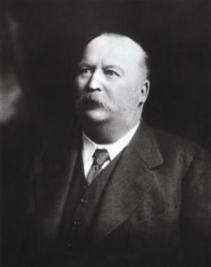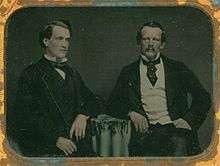William Knox D'Arcy

William Knox D'Arcy (11 October 1849 – 1 May 1917) was one of the principal founders of the oil and petrochemical industry in Persia (Iran). Concession to explore, obtain, and market oil, natural gas, asphalt, and ozocerite was given to him and the concession known as D’Arcy concession in Iran.[1]
Early life
He was born in Newton Abbot, England, the son of a solicitor. He attended Westminster School until 1866 when the family emigrated to Australia, settling in Rockhampton, Queensland. D'Arcy continued his studies and chose to follow law, later joining his father's business. He did well and began to speculate, initially in land.
He married Elena Birkbeck of Rockhampton at St Patrick's Cathedral, Parramatta on 23 October 1872.[2] Elena was born in Mexico in 1840, the only daughter of Damiana de Barre Valdez and Samual Birkbeck, a mining engineer from Illinois in the United States, who was in Mexico managing a silver mine. He was descended from the English Birkbecks, a Quaker family with an interest in education.[3]
Mining in Australia and New Zealand

In 1882 he became a partner, with Walter Russell Hall and Thomas Skarratt Hall, in a syndicate with Thomas, Frederick and Edwin Morgan when they opened a mine on Ironstone Mountain (later renamed Mount Morgan), in Queensland, 24 miles (39 km) south of Rockhampton. There was a significant deposit at Mt Morgan. In October 1886, the syndicate became the Mount Morgan Gold Mining Company, with D'Arcy a director and the largest shareholder. He held 125,000 shares in his own name and 233,000 in trust. At one stage the shares reached £17/1s/- each, making them worth more than £6 million (an amount equivalent to £603 million in present-day terms[4]). The company also worked a rich gold mine at Matakanui, Central Otago, New Zealand, through its subsidiary the Mount Morgan Sluicing Company.
Oil exploration in Persia
In 1889, with a substantial fortune, he and his family moved to England. He bought the Stanmore Hall mansion, Bylaugh Park and a house on Grosvenor Square. His wife Elena died in 1897 and in 1899 he married Nina Boucicault (Nina was a first cousin of her namesake, Nina Boucicault, the celebrated Irish stage and film actress), who helped him entertain on a lavish scale. He had acquired a strong interest in horse-racing while in Australia, and maintained a private box at Epsom racecourse.
In 1900 he agreed to fund a search for oil and minerals in Persia headed by Wolff, Kitabgi and Cotte. Negotiations with the Mozaffar al-Din Shah Qajar began in 1901 and with the offer of £20,000 for a sixty-year concession to explore for oil—the D'Arcy concession—was secured in May covering 480,000 square miles (1,200,000 km2). The concession stipulated that William D'Arcy would have the oil rights to the entire country except for five provinces in Northern Iran. In exchange the Iranian government was given 16% of the oil company's annual profits, an agreement that would haunt the Iranians up until the late 20th century. After the D'Arcy concession the British became much more concerned with the stability of Iran because of their reliance on the country's vast oil reserves.[5]
A drilling team under George B. Reynolds was sent to Persia and began to search. In 1903 a company was formed and D'Arcy had to spend over £500,000 to cover the costs. False hopes were raised in 1904 and D'Arcy was forced to find further financial support, with the Burmah Oil Company Ltd. agreeing to put up to £100,000 into the venture in return for much of the stock.
Drilling in southern Persia at Shardin continued until 1907 when the search was switched to Masjed Soleyman (Masjid-I-Sulaiman in Persian مسجد سلیمان) in a place named "Maidan-i-Naftun". Drilling began at one site in January 1908 and at another nearby in March. By April with no success the venture was close to collapse and D'Arcy almost bankrupt, but on 16 May there were encouraging signs and on 26 May at 1,180 feet (360 m) they struck oil.
In April 1909 D'Arcy was made a director of the newly founded Anglo-Persian Oil Company (APOC) which would later become British Petroleum. By 1911 APOC had run a pipeline from the find to a refinery at Abadan. In 1912 the Mount Morgan company was listed in London and D'Arcy was made chairman of that board.
The financial support given by Burmah Oil and the British Admiralty meant that D'Arcy could no longer put his name to the new company despite the best efforts of his wife, and ended up just a shareholder to the company.[6]
Later life
Later in life he lived in 'Stanmore Hall', Middlesex. It was enlarged by Brightwen Binyon in 1888-91. A billiard room and new dining room were created.[7] Then he commissioned from William Morris and Edward Burne-Jones a suite of tapestries, 'The Quest of the Holy Grail', that were displayed on the hall and staircase, (now dispersed).[8] He also owned paintings by Frank Dicksee and Frederick Goodall.
He died on 1 May 1917.
References
- ↑ Abbasi, Sadegh. "Britain's Major Plunder of Iranian Oil in 1903". english.khamenei.ir. Retrieved 4 January 2016.
- ↑ John Robert Peach (2008). The Greatest-Ever Mining Swindle in the Colonies. ISBN 1-876819-77-4.
William Knox D'Arcy married Damiana “Elena” Birkbeck, only daughter of ...
- ↑ George Birkbeck, founder of the London Mechanics' Institute was a family member.
- ↑ UK CPI inflation numbers based on data available from Gregory Clark (2016), "The Annual RPI and Average Earnings for Britain, 1209 to Present (New Series)" MeasuringWorth.
- ↑ Cleveland, William L. (2004). A History of the Modern Middle East. Boulder, CO: Westview Press. p. 144. ISBN 0-8133-4048-9.
- ↑ Yergin, Daniel (1991). The Prize: The Epic Quest for Oil, Money, and Power. Pocket Books. p. 148. ISBN 0-671-79932-0.
- ↑ Bridget Cherry, Nikolaus Pevsner London 3: North West , p. 294, at Google Books
- ↑ "GREAT STANMORE". british-history.ac.uk. Retrieved 22 September 2014.
External links
- Carment, David (2006). "D'Arcy, William Knox (1849 - 1917)". Australian Dictionary of Biography, Online Edition. Australian National University. Retrieved 2007-04-04.